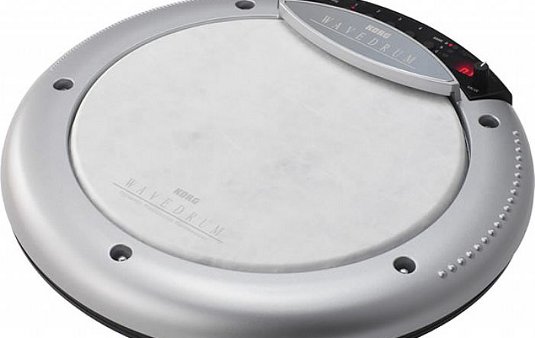DJ & Studio Equipment – Korg Wavedrum Dynamic Percussion Synthesizer review
Originally released in 1994, Korg’s Wavedrum became an instant classic – a truly unique innovation for its time. Juno Plus scribe Ben Daly explores the next generation Wavedrum to find out if this version is just as groundbreaking.
On first impressions, the Wavedrum’s styling is very clean and simple with an understated, modern appearance. Its robust feel and attractive finish ooze the high-quality you’d expect from Korg. The Wavedrum is definitely no kid’s toy, bearing a substantial weight and size (without being heavy or cumbersome). All the controls are nicely tucked away at the top of the synthesizer along a small operating panel which includes two rotary knobs, six buttons and a 3-character, 7-segment LED display. All the Wavedrum’s sockets are located directly below this panel – they include an aux input (for mixing the signal from any audio source to play along with), a headphone output (perfect for playing without disturbing others), jack left and right outputs, a power switch and an AC adaptor socket to power the unit. This clutter-free layout provides plenty of room to maneuver while playing, without pulling cables out or pressing buttons accidentally, which is ideal for slightly heavy-handed (or dare I say clumsy) players.
“Even after only a few minutes with the Wavedrum, it’s instantly apparent how intuitive it is to play and how well it responds to different nuances and playing styles thrown at it”
Switching on for the first time, the Wavedrum enters live mode, which takes a short while to load 12 sounds from its bank of 200 instruments. These 12 sounds are spread across three banks (a, b & c) each containing four sounds. In live mode, these 12 frequently-used sounds can be recalled quickly and conveniently at the touch of a button, making them perfect for live performances. They can also be easily edited or swapped for different sounds by the user for a tailor-made setup.
Even after just a few minutes with the Wavedrum, it’s instantly apparent how intuitive it is to play and how well it responds to different nuances and playing styles thrown at it. Hitting, rubbing, scratching or pushing the playing head in different ways gives remarkable, varied results, as does changing the point you strike the head or velocity with which you strike it. The outer rim of the Wavedrum also has small, raised notches on either side, which, when scraped with a drumstick, give a unique guiro inspired twist to the sound.
For an electronic instrument, the Wavedrum has a very organic feel to it, owing mainly to the fact that the head is an actual drum skin and not a rubber pad like some other electronic percussion instruments. The drum skin is user-replaceable and can be changed fairly easily should it get damaged or need switching. The drum skin is held in place by five tension bolts, which can also be loosened or tightened depending on preference.
The beauty of the Wavedrum is that styles or instruments that usually take time to master become much more accessible to novice percussionists. This is because the Wavedrum allows you to play such a variety of instruments from tablas to bongos and cajons, without actually having to learn the intricacies of the real instruments. Purists may see this as a downfall of the Wavedrum over the real instrument; but surely accessibility is a good thing.
Specification-wise, the Wavedrum has a total of 200 instruments, 100 assigned to the rim and 100 to the head. There are 200 programs in total, 100 of which are presets and the other 100 user definable. The Wavedrum also has 100 loop phrases built-in across various genres and tempos, which are the perfect accompaniment for jamming along or practicing to. Onboard reverb and delay effects are also present and offer a nifty way of adding depth and presence to the sounds.
“The beauty of the Wavedrum is that styles or instruments that usually take time to master become much more accessible to novice percussionists”
Boasting so many features and sounds in such a modestly-sized unit makes the Wavedrum a very versatile companion that belongs in any DJ or percussionists arsenal. The size alone means travelling musicians needn’t worry about lugging around bulky, heavy instruments anymore, or those who lack space for the real instruments can still have them, or a least a faithful representation of them.
Sounds-wise, the Wavedrum has all the classic percussion instruments (djembes, congas, bongos and Tablas) but also has many unique, curious instruments like pailas, tumbas, gamelans and Iya Bocas. Some of the programs also have unusual, strange sounds, with names like D&B synth, the Serengeti, Angry Gods and Alien Communication.
The Wavedrum is an addictive product that’s easy to learn how to use and perfect for adding a unique slant to DJ sets or live performances. The percussion instrument sounds are convincing and it’s pretty hard to find fault with Korg on this.
Review: Ben Daly

